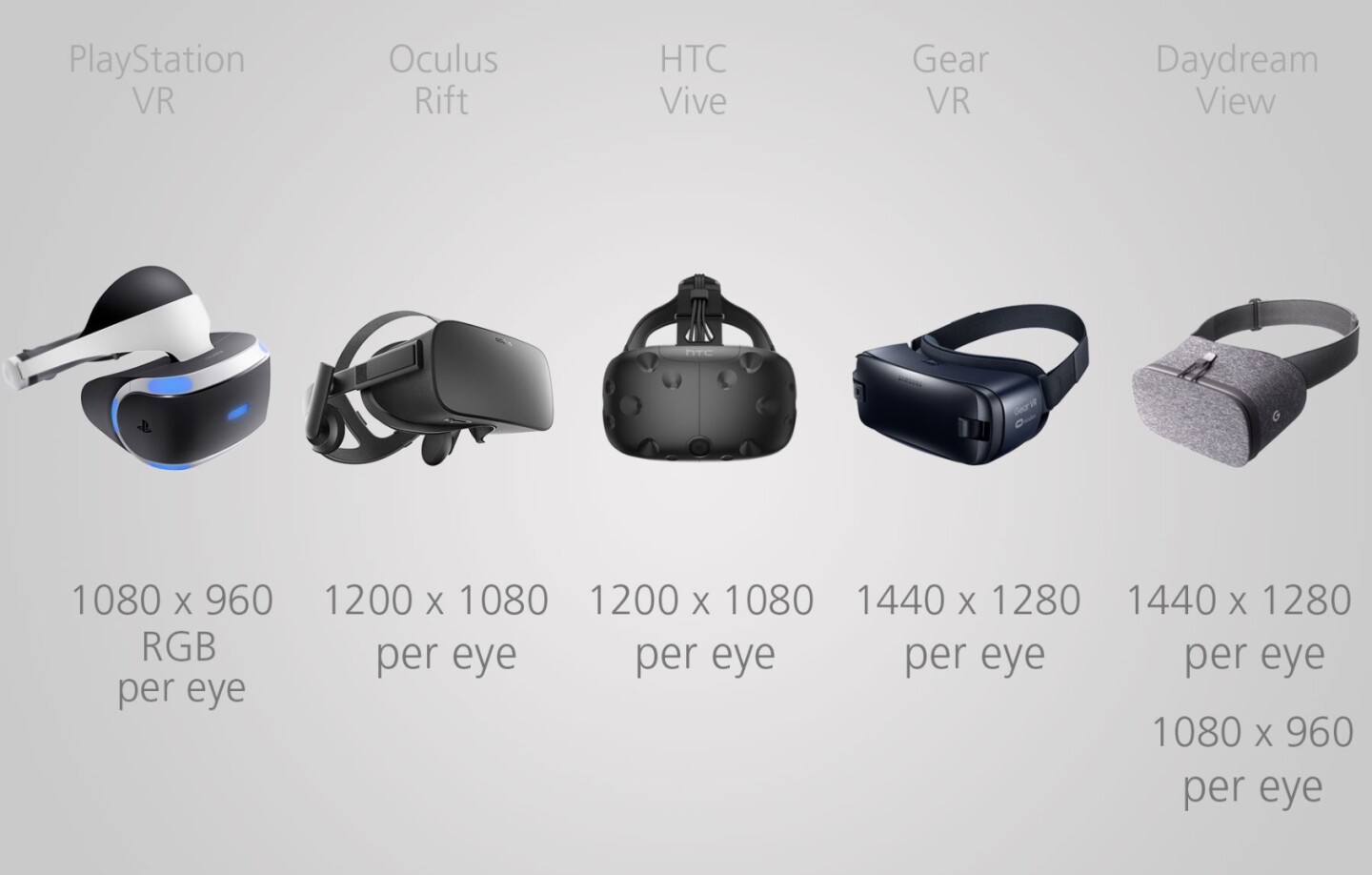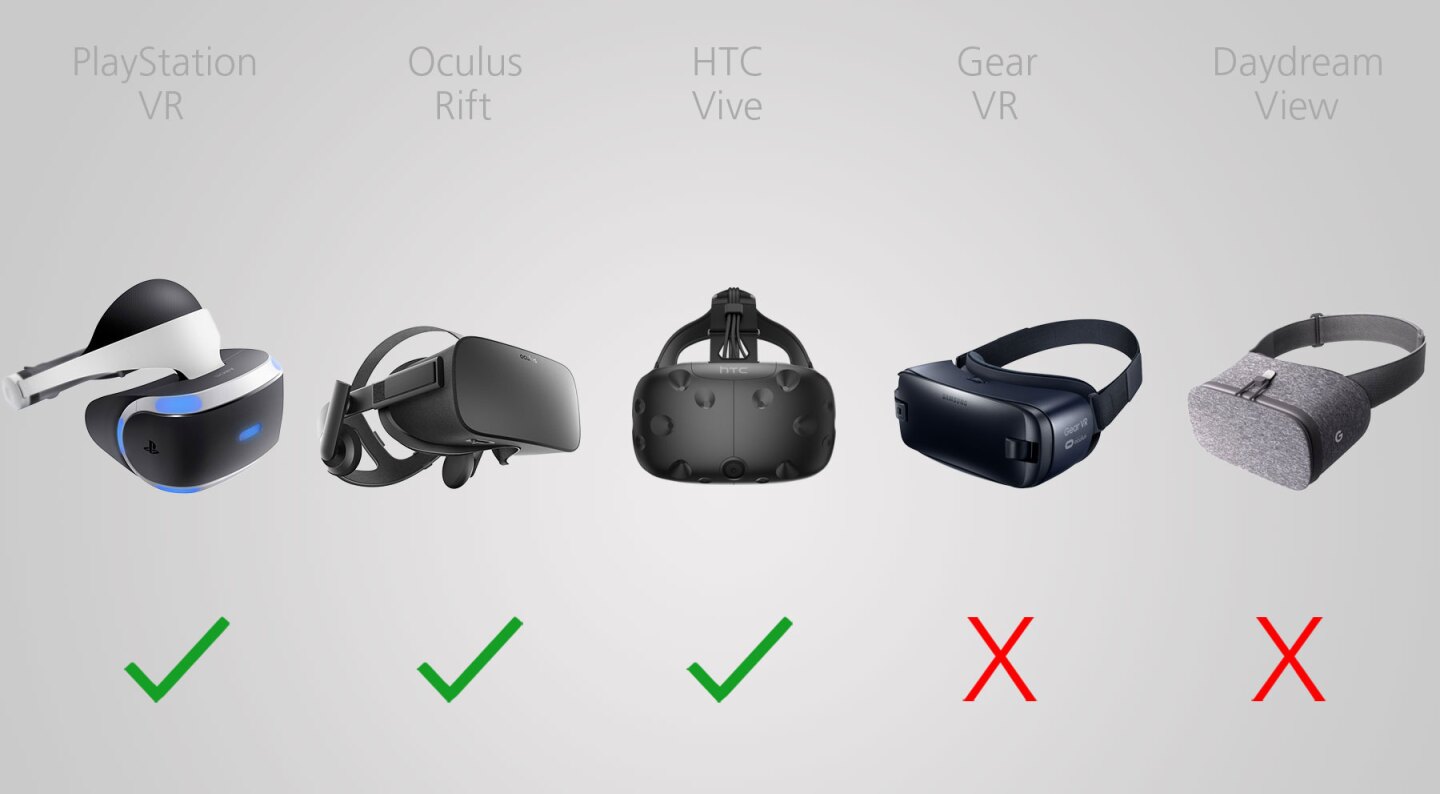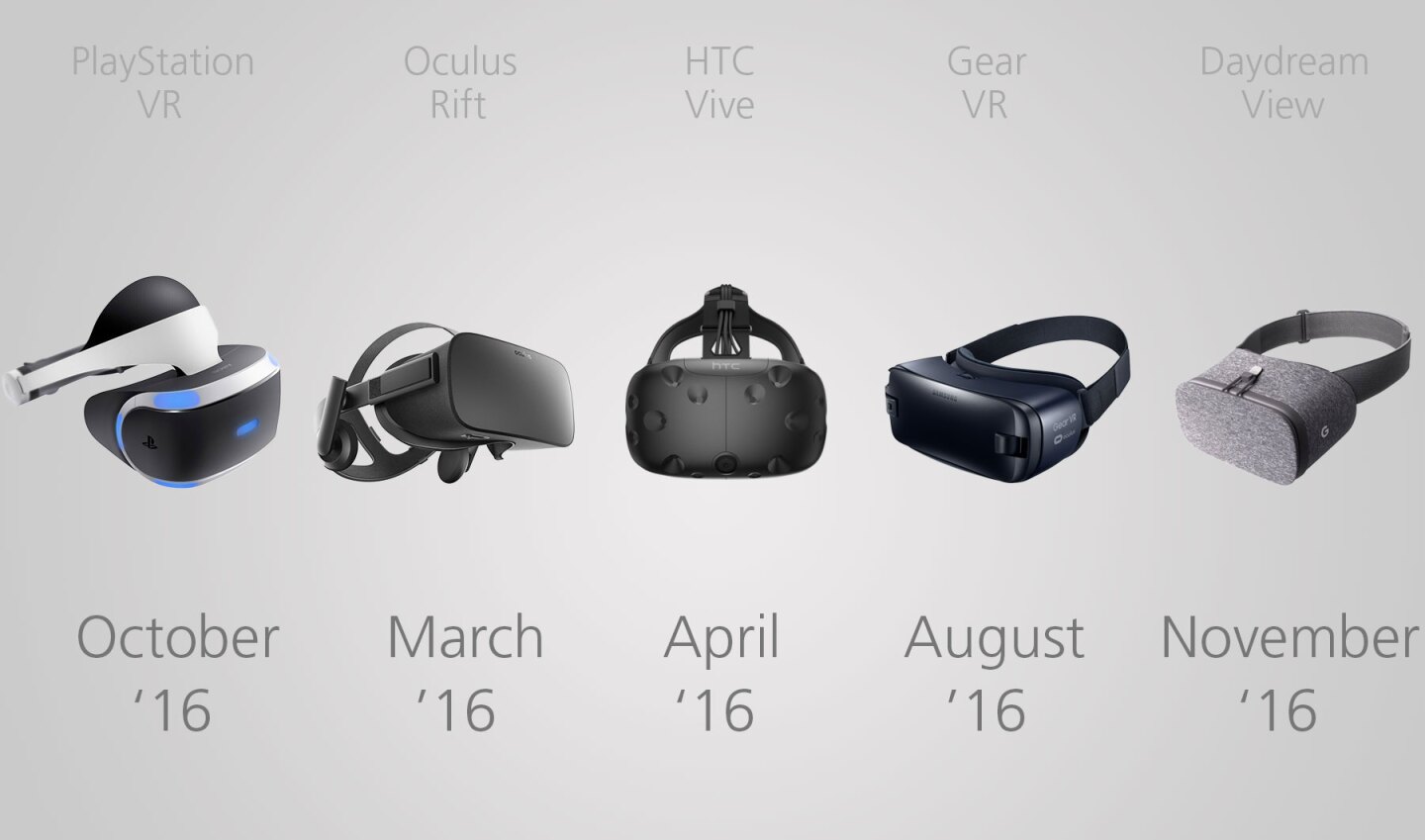This year will mark the first holiday season where at least some kids young and old will be unwrapping packages with full virtual reality systems inside. Now that we (mostly) know what the five big VR headsets of 2016 have in store, let's line them up, compare their details and help you make a decision for yourself or a loved one. It's New Atlas' 2016 VR Comparison Guide.
Build

Plastic is the norm with VR headsets, though Google took what Oculus started – some fabric on the sleek Rift – and kicked it up a notch with the mostly-fabric Daydream View.
Base station

A VR headset is little more than a pair of convex lenses with a display or two hidden behind. So the gizmo that powers the headset is going to be one of the biggest determinants of overall quality.
The two PC-based headsets, Oculus Rift and HTC Vive, are far and away the most powerful. In fact these are the only two VR systems today that we'd describe as high-end. That also, however, means they're crazy-expensive. Those are no ordinary PCs powering these headsets; they're pricey gaming machines that meet very specific standards for VR.
In theory, Sony would hit the perfect middle-ground for consumers, as it draws on the dynamism of the capable-but-not-costly PS4. You know, the one that's already been sold more than 40 million times, and may already be sitting under your TV. Unfortunately, we see PlayStation VR as a broken product that we can't recommend as a legit VR system (read on).
The wild card is entry-level mobile VR: the Samsung Gear VR and Google Daydream View. The basic illusion of VR is surprisingly solid there, considering their smarts come from smartphones that you slide inside hollow headsets. They are, however, missing some key features with an experience that sits at least a few notches below the high-end.
The Gear VR requires one of six compatible Samsung Galaxy phones; right now Daydream View only works with two phones, Google's own Pixel and Pixel XL.
Base station starting price

These are the (in some cases rough) starting prices for those base stations. A PS4 is relatively cheap, while the gaming PCs required for the Rift and Vive are anything but.
Oculus did recently announce a clever workaround that will soon allow the Rift to run on a cheaper (US$500+) gaming machine: It can use a graphics card that only produces 45-fps (frames-per-second) feeds, but uses some background processes that fill in the blanks with synthetic frames – so the headset still shows a more desirable 90 fps. Since we haven't tested this, though, you should take that with a few grains of salt. For now, you may still want to play it safe and buy a more standard $800+ VR-ready PC if you're getting the Rift.
We listed the approximate full retail starting price for the cheapest phone that works with the Gear VR, 2015's Galaxy S6. But remember that a) you can probably find it for cheaper if you buy it used or shop around and b) most people buy phones with little or no money upfront on installment plans.
Positional tracking

This is a sharp line in the sand between mobile VR and PC- or console-based VR. The mobile stuff only tracks your head rotation: Move or lean your body and the virtual world moves or leans with you (an odd, jarring, sensation). With positional tracking on the higher-end setups, you also move and lean inside the virtual world, easily the more instinctual and logical result.
Motion controllers

Motion controls "give you hands" inside virtual worlds. Oculus Touch for the Rift and the Vive's controls both do a great job with this, though the leading Touch has far better ergonomics and capacitive sensors that know when you're lifting your thumbs or index fingers.
This is PlayStation VR's Achilles' heel. In our experience, its PS Move motion-control-tracking is nothing short of terrible – leading to juddering, pulsating and chopping virtual hands. For this reason alone, we don't recommend buying PSVR until Sony releases a revamped camera and controller system (something the company has yet to address).
Mobile VR doesn't yet have real motion controls. Daydream View has a remote that can do some basic motion-sensing, but a) it's only one remote, not a pair and b) it's more about pointing the occasional virtual wand or gun than it is giving you "hand presence" inside VR.
Motion controller price

Sony's godawful PS Move controllers ring up for around $50 for the pair, but do yourself a favor and avoid them like the plague. The excellent Oculus Touch costs $199, while the Vive's high-quality motion controls have been bundled with the headset since its April launch.
Tracking system

PSVR and Oculus both use camera-based sensors to track your headset and controllers, though the Rift's camera system is far superior. The Rift itself includes one sensor, Oculus Touch includes a second, and you can optionally buy a third one to move it into true 360-degree tracking (read on).
The Vive's Lighthouse system works almost exactly in reverse of camera-based tracking. Instead of watching over the headset and controls from the outside, it includes two mountable boxes that transmit invisible lasers; photosensors on the headset and controllers then use those lasers to determine their own positions in space. Much like a ship would use a beacon of light from a lighthouse to figure out where it is and where it's going.
PSVR's tracking, at least for its motion controllers, is (again) so unreliable it breaks the core illusion of VR.
Tracking system price

If you ignore our advice and buy PSVR, you'll need to pay around $55 – in addition to the controllers – to get the PS4 Camera sensor.
You'll only need to buy a third Rift sensor if you want full 360-degree tracking and future room-scale VR. At launch, developers have all designed their Oculus Touch games for 180-degree (two sensors side-by-side) tracking.
360-degree tracking

The first three headsets are capable of tracking in full 360 degrees. We put an asterisk next to PSVR, though, because of the tracking quality (or lack thereof). The Rift's asterisk is because you'll have to buy that third sensor to do this, and right now there aren't any Rift games built from the ground-up for full 360 VR.
The Vive is the only one with a content library tailored for 360-degree tracking.
Room-scale boundaries

The Vive invented the phrase room-scale VR, where you're free to roam around your entire space and are only limited by physical obstacles. It's the most physical and immersive form of VR today.
For this to work, though, you need something to tell you when you're about to smack into a wall or other obstacle. The Vive's Chaperone does this by popping up a virtual wall that represents the edge of your designated playing space.
Oculus Touch also has an answer to Chaperone called Guardian, which we prefer to the Vive's approach: It can trace irregularities in your playing space (sections that jut in and out) while the Vive can only display its virtual walls in a perfect rectangle.
Built-in camera

The Vive has a forward-facing camera that lets you quickly get a view of your surroundings. Technically the Gear VR can do this too, but it's a slower and cumbersome process, compared to the easy double-clicking of the Vive controller.
Remote

For the purposes of this comparison, we'll call Daydream View's bundled controller a remote, rather than a full-on motion controller – though it's more like a hybrid remote/motion-control.
The Oculus Rift also includes a (very similar-looking) remote so you can select items when you aren't using a gamepad or Oculus Touch.
Gamepad support

All but Daydream View support traditional gamepads. Google sees its bundled remote as all the controller you'll need.
Bundled gamepad

The Oculus Rift includes an Xbox One controller in the box. PSVR itself doesn't include a gamepad, but the requisite PS4 does.
Display resolution

The mobile VR headsets actually have the sharpest resolution (though Daydream View's resolution will be lower if you're using the smaller of the two Google Pixel phones).
But that doesn't mean better-looking visuals. The graphics-processing prowess of the base station plays a much bigger factor in that: Therefore the Rift or Vive look the best by far. And the better the graphics card you buy for the connected gaming PC, the better they'll look.
Display type

OLED or AMOLED display panels have lower persistence (less ghosting effect, where an image hangs around longer than it should) and deep blacks, making them ideal for VR.
Field of view

The Vive and Rift also have the widest field of view.
The lower the FOV, the more you'll feel like you're looking through a porthole on a submarine; the wider the FOV, the closer it gets to normal vision. Though none of today's VR comes remotely close to the human eyes' ~180-degree field of view.
Refresh rate

PSVR is capable of the highest frame rates, which adds to your sense of presence in virtual worlds, while the mobile headsets' capabilities are below the 90 fps that's considered today's minimum benchmark for high-quality VR.
Wireless

About the only advantage that the two mobile VR headsets have (apart from pricing) is that they cut the cords and go completely wireless. The Vive, Rift and PSVR have you moving around with a long cable snaking behind you.
Glasses support

All five headsets let you wear glasses underneath. We can say, though, that the Rift isn't particularly comfortable this way, and we haven't yet tried Daydream View with specs.
Focus adjustment

You won't need to wear your glasses with the Gear VR, though, because it has a nifty focus adjustment wheel that lets you tweak the picture just right for your prescription.
IPD adjustment

Interpupillary distance measures the space between the centers of your two pupils: Headsets that let you tweak this help you to line the two pictures to get your virtual world looking just right.
Lens distance (from eyes) adjustment

PSVR and the Vive also let you adjust how far the lenses sit from your eyes, handy if you wear glasses.
It works a bit differently in both cases though: With PSVR the entire visor slides forwards and backwards to find the right fit. In the Vive, the headset itself stays put and only lenses move forwards and backwards. The Vive's approach is better for reducing light leakage, which can reduce your sense of immersion.
Built-in headphones

The Oculus Rift has built-in headphones, which contribute to a simple- and unified-feeling product.
Software

Available content is a big factor, but most of the systems here are in good shape. The Rift has VR's premier content library, while the Gear VR has by far the best selection of mobile content.
The Vive has the best (right now only) selection of 360-degree, room-scale games, which are the most immersive, but the slow rate of high-quality Vive releases since its April launch has lowered our recommendation of Valve's and HTC's system.
Note that we're counting the Oculus Store as the Rift's primary storefront, and Steam for the Vive. But both headsets can often run content from both stores (though not always optimized or user-friendly).
PSVR launched with a good gaming lineup, as you'd expect from a PlayStation product, but we can't stress enough how much its glitchy motion-control-tracking spoils that, at least for titles that aren't gamepad-based.
Google Daydream's library has the most catching up to do. At launch, it has a grand total of 12 games, compared to the Gear VR's hundreds.
Release

The Oculus Rift launched in March, but it didn't become a complete system until the Touch controllers launched in early December of 2016.
Headset price

If you already own one of the required smartphones, mobile VR is a dirt-cheap entry-point for diving into the world of virtual reality. It doesn't hold a candle to the high-end stuff, but if you grade it on a pricing curve, it still comes out looking pretty good.
Total starting price

When you add up headset, base station (PC, console or smartphone at full retail cost), tracking system and motion controls, these are the (rough) starting prices you get. The Rift is a bit cheaper than the Vive due to those cheaper systems that render content at 45 fps, but they aren't available just yet.
The Rift and Vive are the only true high-end setups and are, far and away, the best systems. While we picked the Vive earlier this year, we now prefer the Rift after using the Touch controllers and seeing the additions of 360 tracking and virtual boundaries.
For more on each system, you can hit up our individual reviews:
Shopping for VR gifts and want some more suggestions? Check out our VR Holiday Gift Guide and our picks for the best VR headsets of 2016.

































